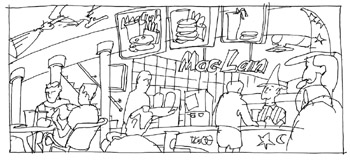Mixed Emotions
|
|
It has been said that the Navi-key user interface sometimes 'feels magical' (see Chapter 3); that is, it seems to guess what the user wants to do next. Careful analysis of user needs and probable subsequent actions results in a design that is efficient to use, but it also evokes an emotional reaction of surprise and admiration. Have the designers intentionally created a product that causes positive emotional reaction?
Emotions are very difficult to analyze. They are people's immediate and subconscious reaction to changes in the environment, and beyond that nobody has been able to properly define what emotions actually are. There's no definite and widely accepted list of all possible emotions. Even if there were, emotions are usually mixed with each other: joy with surprise; anger with sorrow; or possibly more than two at the same time. Even as the conscious mind tries to decipher the emotion, it changes or passes.
To design for a desired emotional effect, we would first have to measure the emotional effect of a product. There are currently two possible ways to attempt it. First, it is possible to measure physiological phenomena that occur when a person is experiencing emotions. These include facial expressions and changes in the person's voice, galvanic skin response, and electrocardiographic, electroencephalographic, and electrooculographic (EKG, EEG, EOG) tracings. The challenge in this form of analysis ('affective computing') is that there is no straightforward formula to calculate the emotions based on the measurements.[4]
The other approach is to use subjective analysis. Users of the product are asked about their feelings before, during, or after use. The challenge of subjective analysis is that it is problematic for most people to identify their own emotions precisely. How questions are worded in any attitude scale (there are several in use) can easily influence the rating because emotions are difficult to describe. We've even seen some attempts to avoid the problems inherent in expressing emotions through language by using pictures and animation to describe these emotions.[5] Although in its infancy, the research has the potential of providing important information about specific rather than general emotions. It is naturally more interesting to the designers to know if the users feel fascination or pride rather than generally finding the product pleasant.
Given the intractability of these obstacles, designers can take a third approach: design by intuition and empathy. Designing for emotional effect doesn't necessarily have to be measurable to the finest granularity. Good results can be obtained simply by allowing emotions to be a design driver in product design. In this case the designer becomes a sort of surrogate for the user. The designer can use different stimuli to put the user in the right mood for designing emotional products and can also collect information from the end users that contain emotional clues.[6]
Let's say that a mobile phone designer wants to experiment with emotional design, and decides to create a mobile phone that will not get too predictable-or boring-during the long period of product ownership. The phone currently provides a standard feedback notification 'message sent' when a text message has been successfully launched. The same feedback could be provided to the user in hundreds of different ways. The feedback might be an animation and a subtle sound effect that is different every time. The user could never expect the subtle feedback that the phone is providing this time. Still, the usability would not be compromised. When all the animations and sounds have been used, the phone could automatically download new ones from the network. Similarly, all other features of the current phone could be redesigned to provide a surprising effect.

Some emotional designs may require the deployment of advanced technologies. Consider the 'funny' phone. Right now devices are static; they contain only the features and information that have been programmed in them. A device that tells the same joke twice is not funny. To continue being funny, it will therefore need to change its behavior. This requires that the device adapt to the user. Using affective computing technology, the device could actually sense what kind of jokes the user typically laughs at and present only jokes of that type. Naturally, the device can log which jokes the user has already seen to avoid presenting the same joke twice. When devices can be connected to the Internet and their users form a community, we can imagine an ecosystem where each device borrows material from the interactions of other users with their similar devices. Such devices could learn hundreds of new jokes every day for an indefinite period of time.
[4]R. Picard, Affective Computing. Cambridge, Mass.: MIT Press, 1997.
[5]P. Desmet, P. Hekkert, and J. Jacobs, 'When a Car Makes You Smile: Development and Application of an Instrument to Measure Product Emotions,' Adv. Consumer Research 27: 111-117 (2000).
[6]B. Gaver, T. Dunne, and E. Pacenti, 'Design: Cultural Probes,' ACM Interactions 6(1): 21-29 (1999).
|
|
EAN: 2147483647
Pages: 142